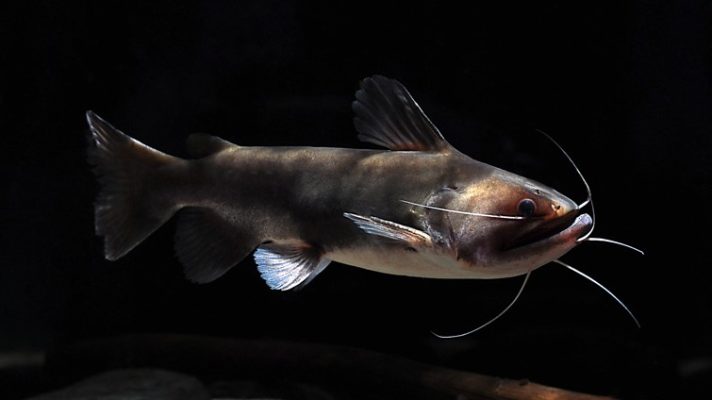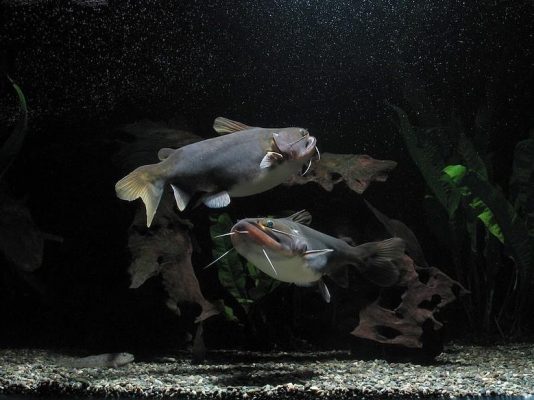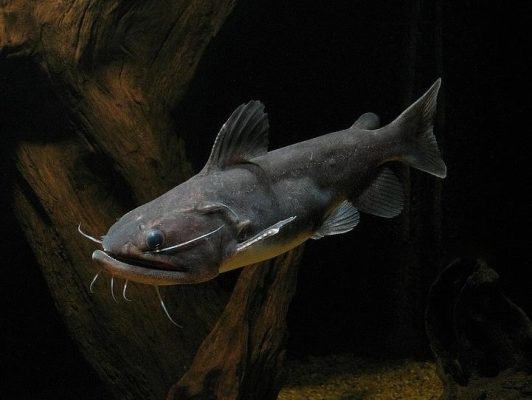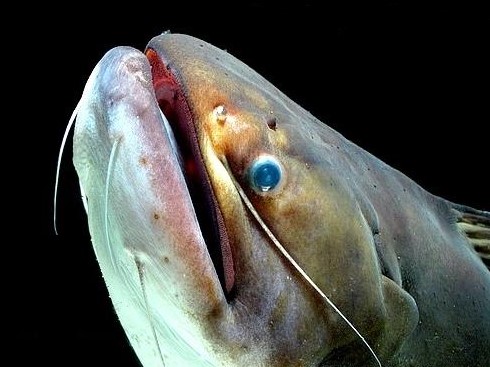Gulper Catfish

Table of Contents
- Introduction
- Taxonomy and Classification
- Habitat and Distribution
- Behavior and Adaptations
- Physical Characteristics
- Diet and Feeding Strategies
- Conclusion
Introduction
The Gulper Catfish (Asterophysus batrachus) is a truly remarkable species that captivates the attention of scientists and nature enthusiasts alike. With its distinct characteristics, large size, and abnormal appearance, this unique catfish species has piqued the curiosity of researchers and has become a subject of great interest in the scientific community.
1. Size and Appearance
One of the most striking features of the Gulper Catfish is its size. Growing up to 3 feet in length, it is one of the largest catfish species in the world. Its elongated body and massive head give it a truly imposing presence. The Gulper Catfish is also known for its abnormal appearance, with a disproportionately large mouth that allows it to swallow prey larger than its own size. This remarkable adaptation sets it apart from other catfish species and makes it a fascinating subject for study.
2. Ecological Importance
Studying and understanding the Gulper Catfish is of utmost importance for several reasons. Firstly, its unique feeding behavior and ability to consume prey larger than itself raise questions about its ecological role and impact on the food chain. By investigating its hunting strategies and feeding habits, scientists can gain valuable insights into the dynamics of aquatic ecosystems and the interplay between predator and prey.
3. Habitat and Conservation
Furthermore, the Gulper Catfish’s habitat and distribution are intricately linked to its survival and conservation. By studying its natural habitat and geographical range, researchers can identify key areas that need protection and implement conservation measures to ensure the long-term survival of this species. Understanding the Gulper Catfish’s behavior, reproductive patterns, and interactions with its environment can provide valuable information for conservation efforts and the preservation of its habitat.
In conclusion, the Gulper Catfish is a species that demands our attention and study. Its distinct characteristics, large size, and abnormal appearance make it a fascinating subject for scientific research. By delving deep into its taxonomy, physical characteristics, behavior, and interactions with its environment, we can gain a better understanding of this remarkable species and contribute to its conservation. It is our responsibility to ensure the long-term survival of the Gulper Catfish and preserve its unique place in the natural world.
Taxonomy and Classification
The Gulper Catfish, scientifically known as Asterophysus batrachus, belongs to the Asterophysus genus within the family Auchenipteridae. This family comprises a diverse group of catfish species primarily found in South America. The Gulper Catfish is a fascinating member of this family, known for its distinct physical characteristics and unique adaptations.
Physical Attributes
The Gulper Catfish stands out due to its large size and abnormal appearance. It can grow up to 50 centimeters in length, making it one of the largest catfish species in its habitat. Notably, its head features a wide mouth and elongated jaws, enabling it to swallow prey larger than its own size. This unique feature sets it apart from other catfish species and contributes to its hunting strategies.
Adaptations and Feeding Habits
The Gulper Catfish exhibits a variety of adaptations that allow it to thrive in its environment. Its large mouth and expandable stomach enable it to gulp down prey in one swift motion, making it an efficient predator. This feeding method is advantageous for the Gulper Catfish, as it allows it to consume a wide range of prey, including smaller fish and aquatic invertebrates. By being able to feed on larger prey, the Gulper Catfish has a competitive advantage over other species in its ecosystem.
Taxonomic Classification
The Gulper Catfish is classified under the order Siluriformes, commonly known as catfish. Within this order, it belongs to the family Auchenipteridae, which includes other catfish species found in South America. The Gulper Catfish is further classified under the genus Asterophysus, which consists of only two recognized species, including the Gulper Catfish.
Significance and Conservation
The taxonomic classification of the Gulper Catfish provides valuable insights into its evolutionary history and relationship with other species. It highlights the unique characteristics and adaptations that have allowed this species to survive and thrive in its native habitat. Understanding the taxonomy and classification of the Gulper Catfish is essential for further research and conservation efforts aimed at preserving this remarkable species.
Conclusion
In conclusion, the Gulper Catfish, scientifically known as Asterophysus batrachus, belongs to the Asterophysus genus within the family Auchenipteridae. Its physical characteristics, including its large size, unique head shape, and abnormal appearance, make it a distinct member of the catfish family. Its feeding habits and adaptations, such as its ability to swallow prey larger than its own size, contribute to its success as a predator. By understanding the taxonomy and classification of the Gulper Catfish, we gain valuable insights into its evolutionary history and can better appreciate its significance in the ecosystem. Further research and conservation efforts are crucial to ensure the long-term survival of this extraordinary species.
Habitat and Distribution
Detailed description of the natural habitat of the Gulper Catfish
The Gulper Catfish, scientifically known as Asterophysus batrachus, is a fascinating species that inhabits the freshwater ecosystems of South America. It can be found in various rivers and tributaries, particularly in the Amazon Basin and its surrounding regions. These water bodies provide the ideal habitat for the Gulper Catfish due to their rich biodiversity and abundance of prey.
This species is well adapted to thrive in the dense vegetation and murky waters of its natural habitat. It is commonly found in areas with submerged logs, fallen trees, and dense aquatic vegetation, as these provide ample hiding places and shelter for the Gulper Catfish. These habitats also offer a plentiful supply of food sources, allowing the species to sustain its large size and unique feeding habits.
Discussion of its geographical distribution and range
The Gulper Catfish has a relatively wide geographical distribution, with its range spanning across several countries in South America. It can be found in countries such as Brazil, Peru, Colombia, and Venezuela, where the Amazon River and its tributaries flow through. Within these countries, the Gulper Catfish is known to inhabit specific regions, including the Amazon Basin, Orinoco River, and various other river systems.
It is worth noting that the Gulper Catfish is not evenly distributed throughout its range. Instead, it tends to be more concentrated in certain areas where the environmental conditions are most suitable for its survival. These areas often have slow-moving or stagnant waters, abundant vegetation, and a diverse array of prey species.
Environmental factors important for its survival
The Gulper Catfish is highly adapted to its environment and relies on specific environmental factors for its survival. One crucial factor is water temperature, as this species prefers warm tropical waters. The temperature range of its habitat typically falls between 24 to 28 degrees Celsius (75 to 82 degrees Fahrenheit), providing optimal conditions for its growth and reproduction.
Another important environmental factor is water quality. The Gulper Catfish requires well-oxygenated water to support its respiratory needs. It often seeks out areas with higher oxygen levels, such as near the water’s surface or in areas with strong water currents. This behavior helps the species maintain its metabolic functions and ensures its survival in oxygen-depleted environments.
Additionally, the presence of suitable prey species is vital for the Gulper Catfish’s survival. Its habitat must offer a diverse range of aquatic organisms, including smaller fish, crustaceans, and aquatic invertebrates, which serve as its primary food sources. The availability of these prey species directly impacts the Gulper Catfish’s feeding behavior and overall health.
In conclusion, the Gulper Catfish’s natural habitat and distribution are intricately linked to its unique characteristics and survival strategies. Its preference for specific habitats, such as those with dense vegetation and soft substrates, highlights its adaptation to the complex ecosystems of South American rivers. Understanding the Gulper Catfish’s habitat requirements and distribution patterns is crucial for conservation efforts and ensuring the long-term survival of this remarkable species.
Behavior and Adaptations
Examination of the Gulper Catfish’s behavior in the wild
The Gulper Catfish, also known as Asterophysus batrachus, exhibits fascinating behavior in its natural habitat. One of its most remarkable behaviors is its feeding habits, which involve the ability to swallow prey larger than its own size. This unique adaptation sets it apart from other catfish species and makes it a formidable predator in its ecosystem.
Analysis of its feeding habits and unique adaptations for hunting
The Gulper Catfish has a specialized feeding behavior that allows it to gulp down prey in one swift motion. It possesses an incredibly elastic stomach that can expand to accommodate prey that is much larger than its own body size. This adaptation enables the Gulper Catfish to consume a wide range of prey, including smaller fish and aquatic invertebrates.
The advantage of this unique feeding method lies in the Gulper Catfish’s ability to secure a substantial meal in a single gulp. By consuming larger prey, it minimizes the energy expenditure associated with hunting and increases its chances of survival. This adaptation also allows the Gulper Catfish to exploit a niche in its habitat that may not be accessible to other fish species.
Observations have revealed that the Gulper Catfish tends to exhibit feeding patterns and preferences in specific environments. It is often found lurking near river banks, where it can ambush unsuspecting prey that ventures too close to the water’s edge. This behavior suggests a strategic hunting approach, taking advantage of the Gulper Catfish’s unique morphology and the element of surprise.
Discussion of its reproductive behavior and parental care
The reproductive behavior of the Gulper Catfish is an area of ongoing scientific study. While comprehensive information is still limited, researchers have observed some intriguing aspects of its reproductive strategy. The Gulper Catfish is known to engage in external fertilization, where the female releases eggs and the male fertilizes them with his sperm.
After fertilization, the female Gulper Catfish takes on the responsibility of guarding and caring for the eggs. She carefully selects a suitable location, often a secluded area with ample vegetation, where she deposits the eggs. The female then remains vigilant, protecting the eggs from potential predators and ensuring their survival until they hatch.
This unique parental care exhibited by the female Gulper Catfish highlights its investment in the next generation. It demonstrates the species’ commitment to ensuring the survival of its offspring and contributes to the overall success of the Gulper Catfish population.
In conclusion, the Gulper Catfish’s behavior and adaptations make it a remarkable species worthy of study and conservation efforts. Its ability to swallow prey larger than its own size, strategic feeding patterns, and unique reproductive behavior all contribute to its success in its natural habitat. Further research into the behavior and adaptations of the Gulper Catfish will not only enhance our understanding of this species but also aid in its long-term survival.
Physical Characteristics
The Gulper Catfish, scientifically known as Asterophysus batrachus, possesses a unique and intriguing physical appearance. Its body structure is well-adapted for its predatory lifestyle in its native habitat. Let’s delve into the detailed description of its physical characteristics, including its fins, scales, and coloration.
1. Body Structure:
The Gulper Catfish has a robust and elongated body, which contributes to its ability to capture and swallow prey larger than its own size. Its body is covered in a layer of thick, bony plates called scales, providing protection against potential predators and environmental hazards. These scales also aid in maintaining buoyancy and stability in the water.
2. Fins:
The Gulper Catfish possesses several distinct fins that enable it to maneuver swiftly and efficiently in its aquatic environment. It has a large dorsal fin located on its back, which aids in maintaining balance and stability during swimming. The pectoral fins, positioned on each side of the body, allow for precise control of movement and navigation. Additionally, the Gulper Catfish has a pair of pelvic fins located on the ventral side, which assist in maintaining stability and control during feeding and hunting activities.
3. Scales:
The scales of the Gulper Catfish are unique and play a crucial role in its survival. They are thick and rigid, providing protection against potential predators and physical injuries. These scales are often dark in color, which helps the Gulper Catfish blend into its surroundings and remain camouflaged while hunting or hiding from predators. The scales also contribute to the overall appearance of the Gulper Catfish, giving it a distinctive and intimidating look.
4. Coloration:
The Gulper Catfish exhibits a fascinating coloration pattern that varies depending on its habitat and age. Juvenile Gulper Catfish often display a mottled pattern of dark brown or black spots on a lighter background, providing effective camouflage among rocks and vegetation. As they mature, their coloration may change, and some individuals develop a more uniform dark coloration. This darker coloration aids in their stealthy approach while hunting and ambushing prey.
In conclusion, the physical characteristics of the Gulper Catfish are well-adapted to its predatory lifestyle. Its robust body structure, fins, scales, and coloration all contribute to its ability to thrive in its native habitat. The Gulper Catfish’s unique appearance and physical adaptations make it a truly remarkable species worth studying and understanding. By further exploring its physical characteristics, we can gain valuable insights into its evolutionary history and ecological role in the aquatic ecosystem.
Diet and Feeding Strategies
Overview of the Gulper Catfish’s diet in the wild
The Gulper Catfish, also known as Asterophysus batrachus, is a formidable predator with a diverse diet in the wild. This species has adapted to its environment and developed unique feeding strategies and hunting techniques that allow it to capture a wide range of prey.
Discussion of its feeding habits and hunting techniques
The Gulper Catfish employs various hunting techniques to secure its meals. Its primary hunting strategy involves lying in wait, camouflaging itself among rocks or vegetation, and ambushing unsuspecting prey. This stealthy approach allows the Gulper Catfish to surprise its victims and ensure a successful capture.
One of the most remarkable aspects of the Gulper Catfish’s feeding habits is its ability to swallow prey larger than its own size. This is made possible by its highly expandable stomach, which can stretch to accommodate prey up to three times its own body size. This unique adaptation gives the Gulper Catfish a distinct advantage over its prey, allowing it to consume larger meals and maximize its energy intake.
The diet of the Gulper Catfish primarily consists of smaller fish and aquatic invertebrates. It preys upon species such as tetras, characins, and even other catfish. In addition to fish, the Gulper Catfish also feeds on crustaceans, insects, and other small aquatic organisms. This diverse diet ensures that the Gulper Catfish can adapt to changes in its environment and maintain a stable food source.
The Gulper Catfish’s hunting technique involves a rapid and forceful suction motion, which allows it to engulf its prey in one swift movement. This suction feeding mechanism is facilitated by its large mouth and expandable jaws, which create a powerful vacuum-like effect. Once the prey is captured, the Gulper Catfish uses its backward-facing teeth to prevent escape and begins the process of swallowing its meal whole.
This unique feeding method not only enables the Gulper Catfish to consume larger prey but also minimizes the risk of injury during the hunting process. By swallowing its prey whole, the Gulper Catfish avoids potential injuries from struggling prey or sharp spines, ensuring its own survival and reducing the risk of infection or damage to its sensitive digestive system.
The Gulper Catfish’s feeding habits also exhibit certain patterns and preferences. Observations have shown that it tends to hunt along river banks, where smaller fish and invertebrates are abundant. It is also known to seek out areas with dense vegetation or submerged logs, which provide hiding places for potential prey. These preferences demonstrate the Gulper Catfish’s ability to adapt its hunting strategies to specific environments and maximize its chances of success.
In conclusion, the Gulper Catfish’s diet and feeding strategies are a testament to its remarkable adaptability and predatory prowess. Its ability to consume prey larger than its own size, combined with its stealthy hunting techniques, allows this species to thrive in its natural habitat. Understanding the Gulper Catfish’s diet and feeding habits not only provides valuable insights into its ecological role but also highlights the importance of preserving this unique species and its habitat. Further research and conservation efforts are crucial to ensuring the long-term survival of the Gulper Catfish and maintaining the delicate balance of our aquatic ecosystems.
Conclusion
In conclusion, the Gulper Catfish (Asterophysus batrachus) is a truly fascinating and unique species that deserves our attention and understanding. Throughout this article, we have explored its taxonomy, physical characteristics, habitat, behavior, diet, threats, and conservation status. Let us now recap the main points discussed and emphasize the importance of further research and conservation efforts for the Gulper Catfish.
The Gulper Catfish, belonging to the Asterophysus genus, stands out with its large size and abnormal appearance. Its elongated body, large head, and wide mouth make it a truly remarkable species. Understanding its taxonomy and classification helps us appreciate its place in the natural world and its evolutionary history.
When it comes to its habitat and distribution, the Gulper Catfish is primarily found in the rivers and regions of South America, including the Amazon basin. It thrives in freshwater environments, and its survival is closely tied to the health of these ecosystems. Environmental factors such as water quality and temperature play a crucial role in its well-being.
The behavior and adaptations of the Gulper Catfish are particularly intriguing. Its feeding habits are remarkable, as it has the ability to swallow prey larger than its own size in one gulp. This unique adaptation allows it to thrive in its habitat by consuming smaller fish and aquatic invertebrates. Observations have shown that it often hunts along river banks or in specific environments, demonstrating its adaptability and resourcefulness.
Reproductive behavior and parental care are also important aspects of the Gulper Catfish’s life cycle. Further research is needed to fully understand these behaviors and their significance in the species’ survival and population dynamics.
The Gulper Catfish’s physical appearance, including its body structure, fins, scales, and coloration, adds to its allure. Its distinct features make it easily recognizable and contribute to its ecological role within its habitat.
When it comes to its diet and feeding strategies, the Gulper Catfish employs various hunting techniques to capture its prey. Its ability to gulp down prey in one bite gives it a competitive advantage in its ecosystem. Understanding its feeding habits and strategies is crucial for comprehending its ecological role and potential impacts on prey populations.
Unfortunately, the Gulper Catfish faces several threats to its survival. Habitat destruction, pollution, overfishing, and the pet trade are major concerns that need to be addressed. Efforts to protect and conserve this species are essential to ensure its long-term survival.
Conservation initiatives and regulations are already in place to safeguard the Gulper Catfish and its habitat. However, more needs to be done. It is crucial to raise awareness about the importance of this species and its role in the ecosystem. Further research is needed to fill knowledge gaps and inform effective conservation strategies.
The Gulper Catfish also has interactions with local communities, particularly in terms of fishing practices and cultural significance. Understanding these interactions can help foster sustainable practices and promote the coexistence of humans and this unique species.
In conclusion, the Gulper Catfish is a species that captivates us with its distinct characteristics and behaviors. It plays a vital role in its ecosystem and deserves our attention and conservation efforts. By conducting further research, raising awareness, and implementing effective conservation measures, we can ensure the long-term survival of this remarkable species and preserve the biodiversity of our planet. Let us all join hands in protecting the Gulper Catfish and its natural habitat for generations to come.



